Reading time: 10 min
In times past there lived a king and queen, who said to each other every day of their lives, „Would that we had a child!“ and yet they had none. But it happened once that when the queen was bathing, there came a frog out of the water, and he squatted on the ground, and said to her: „Thy wish shall be fulfilled; before a year has gone by, thou shalt bring a daughter into the world.“
And as the frog foretold, so it happened; and the queen bore a daughter so beautiful that the king could not contain himself for joy, and he ordained a great feast. Not only did he bid to it his relations, friends, and acquaintances, but also the wise women, that they might be kind and favourable to the child. There were thirteen of them in his kingdom, but as he had only provided twelve golden plates for them to eat from, one of them had to be left out.
However, the feast was celebrated with all splendour; and as it drew to an end, the wise women stood forward to present to the child their wonderful gifts: one bestowed virtue, one beauty, a third riches, and so on, whatever there is in the world to wish for. And when eleven of them had said their say, in came the uninvited thirteenth, burning to revenge herself, and without greeting or respect, she cried with a loud voice: „In the fifteenth year of her age the princess shall prick herself with a spindle and shall fall down dead.“ And without speaking one more word she turned away and left the hall.
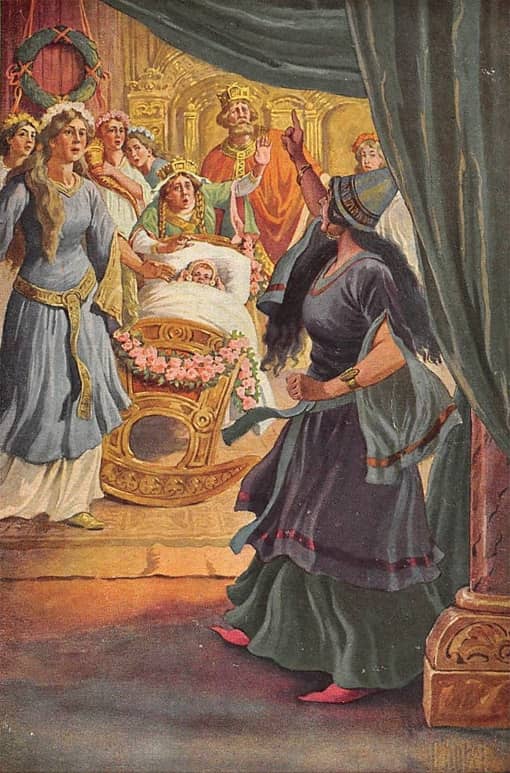 Image: Otto Kubel (1868 – 1951)
Image: Otto Kubel (1868 – 1951)Every one was terrified at her saying, when the twelfth came forward, for she had not yet bestowed her gift, and though she could not do away with the evil prophecy, yet she could soften it, so she said: „The princess shall not die, but fall into a deep sleep for a hundred years.“ Now the king, being desirous of saving his child even from this misfortune, gave commandment that all the spindles in his kingdom should be burnt up. The maiden grew up, adorned with all the gifts of the wise women; and she was so lovely, modest, sweet, and kind and clever, that no one who saw her could help loving her.
It happened one day, she being already fifteen years old, that the king and queen rode abroad, and the maiden was left behind alone in the castle. She wandered about into all the nooks and corners, and into all the chambers and parlours, as the fancy took her, till at last she came to an old tower. She climbed the narrow winding stair which led to a little door, with a rusty key sticking out of the lock. She turned the key, and the door opened, and there in the little room sat an old woman with a spindle, diligently spinning her flax.
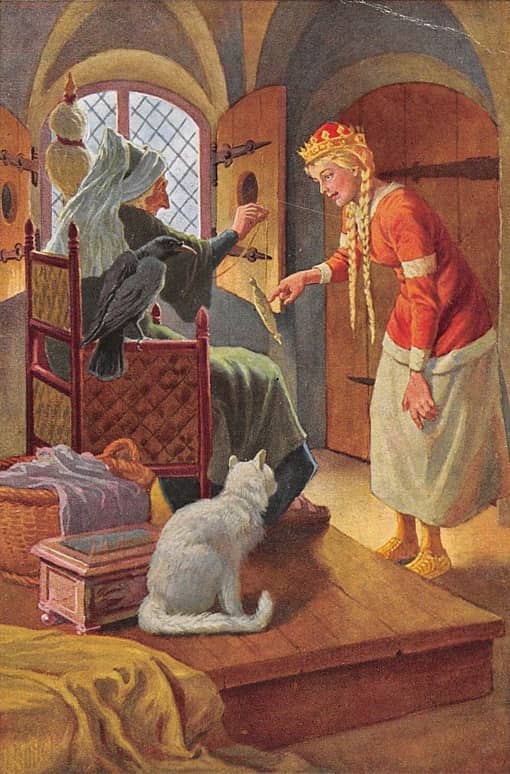 Image: Otto Kubel (1868 – 1951)
Image: Otto Kubel (1868 – 1951)„Good day, mother,“ said the princess, „what are you doing?“ – „I am spinning,“ answered the old woman, nodding her head. „What thing is that that twists round so briskly?“ asked the maiden, and taking the spindle into her hand she began to spin; but no sooner had she touched it than the evil prophecy was fulfilled, and she pricked her finger with it. In that very moment she fell back upon the bed that stood there, and lay in a deep sleep.
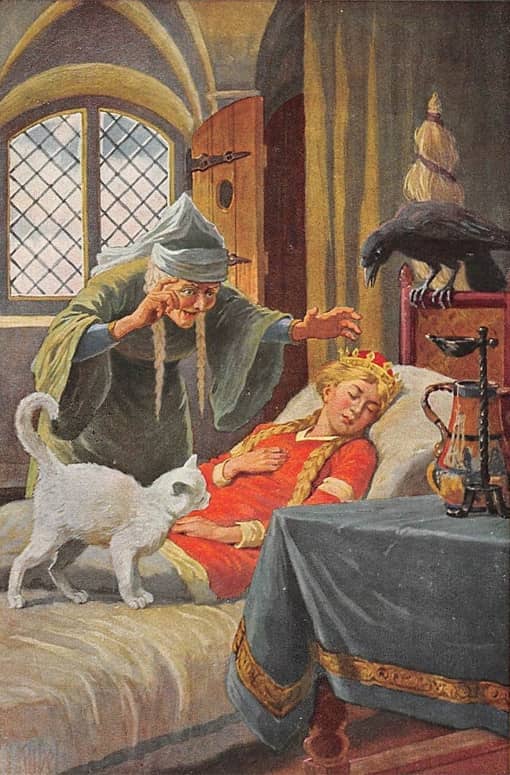 Image: Otto Kubel (1868 – 1951)
Image: Otto Kubel (1868 – 1951)And this sleep fell upon the whole castle. The king and queen, who had returned and were in the great hall, fell fast asleep, and with them the whole court. The horses in their stalls, the dogs in the yard, the pigeons on the roof, the flies on the wall, the very fire that flickered on the hearth, became still, and slept like the rest; and the meat on the spit ceased roasting, and the cook, who was going to pull the scullion’s hair for some mistake he had made, let him go, and went to sleep. And the wind ceased, and not a leaf fell from the trees about the castle. Then round about that place there grew a hedge of thorns thicker every year, until at last the whole castle was hidden from view, and nothing of it could be seen but the vane on the roof.
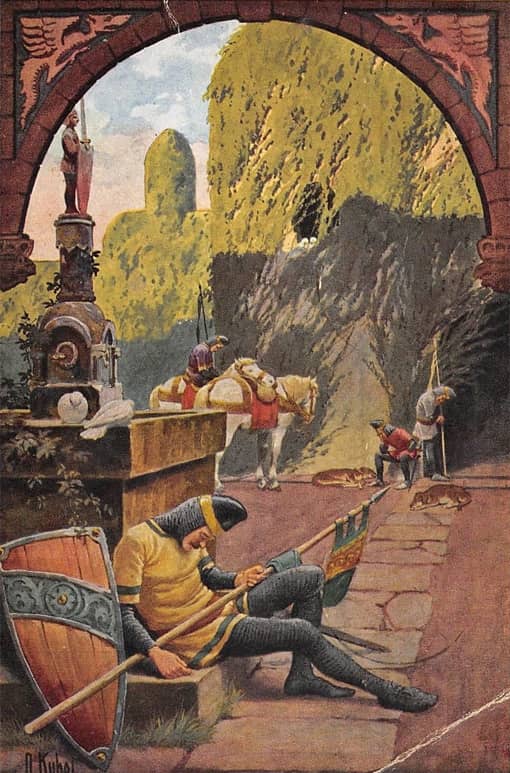 Image: Otto Kubel (1868 – 1951)
Image: Otto Kubel (1868 – 1951)And a rumour went abroad in all that country of the beautiful sleeping Rosamond, for so was the princess called; and from time to time many kings‘ sons came and tried to force their way through the hedge; but it was impossible for them to do so, for the thorns held fast together like strong hands, and the young men were caught by them, and not being able to get free, there died a lamentable death. Many a long year afterwards there came a king’s son into that country, and heard an old man tell how there should be a castle standing behind the hedge of thorns, and that there a beautiful enchanted princess named Rosamond had slept for a hundred years, and with her the king and queen, and the whole court.
The old man had been told by his grandfather that many king’s sons had sought to pass the thorn-hedge, but had been caught and pierced by the thorns, and had died a miserable death. Then said the young man: „Nevertheless, I do not fear to try. I shall win through and see the lovely Rosamond.“ The good old man tried to dissuade him, but he would not listen to his words. For now the hundred years were at an end, and the day had come when Rosamond should be awakened.
 Image: Otto Kubel (1868 – 1951)
Image: Otto Kubel (1868 – 1951)When the prince drew near the hedge of thorns, it was changed into a hedge of beautiful large flowers, which parted and bent aside to let him pass, and then closed behind him in a thick hedge. When he reached the castle-yard, he saw the horses and brindled hunting-dogs lying asleep, and on the roof the pigeons were sitting with their heads under their wings. And when he came indoors, the flies on the wall were asleep, the cook in the kitchen had his hand uplifted to strike the scullion, and the kitchen-maid had the black fowl on her lap ready to pluck.
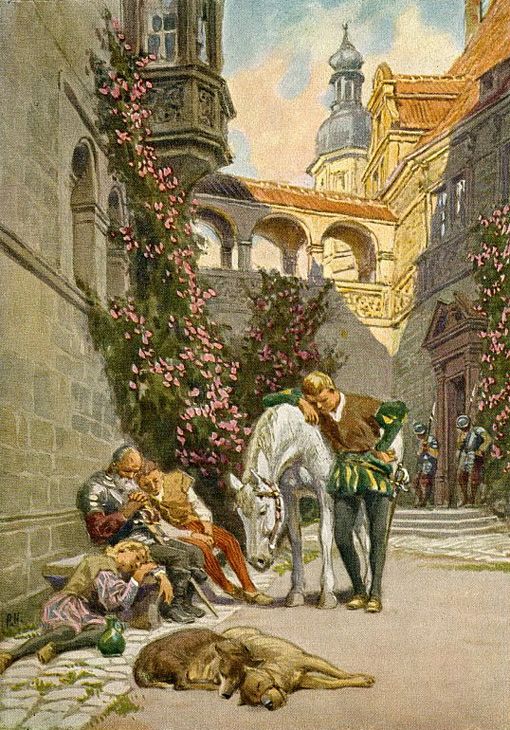 Image: Paul Hey (1867 – 1952)
Image: Paul Hey (1867 – 1952)Then he mounted higher, and saw in the hall the whole court lying asleep, and above them, on their thrones, slept the king and the queen. And still he went farther, and all was so quiet that he could hear his own breathing; and at last he came to the tower, and went up the winding stair, and opened the door of the little room where Rosamond lay. And when he saw her looking so lovely in her sleep, he could not turn away his eyes; and presently he stooped and kissed her. And she awaked, and opened her eyes, and looked very kindly on him.
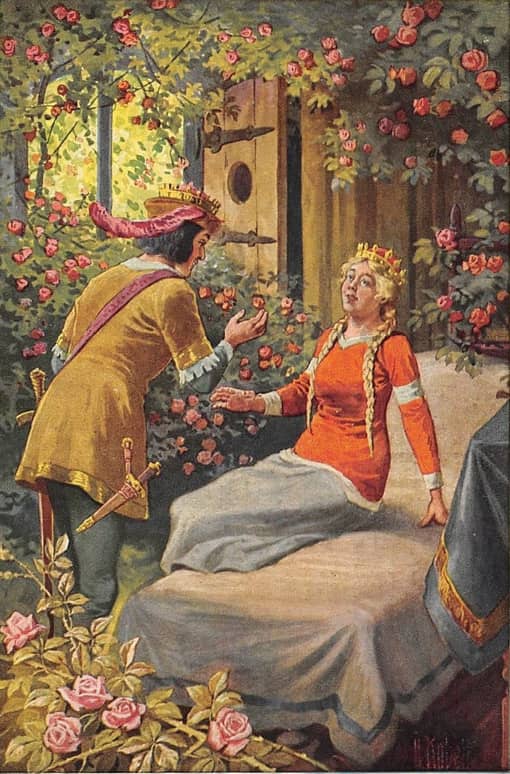 Image: Otto Kubel (1868 – 1951)
Image: Otto Kubel (1868 – 1951)And she rose, and they went forth together, and the king and the queen and whole court waked up, and gazed on each other with great eyes of wonderment. And the horses in the yard got up and shook themselves, the hounds sprang up and wagged their tails, the pigeons on the roof drew their heads from under their wings, looked round, and flew into the field, the flies on the wall crept on a little farther, the kitchen fire leapt up and blazed, and cooked the meat, the joint on the spit began to roast, the cook gave the scullion such a box on the ear that he roared out, and the maid went on plucking the fowl. Then the wedding of the Prince and Rosamond was held with all splendour, and they lived very happily together until their lives‘ end.
 Learn languages. Double-tap on a word.Learn languages in context with Childstories.org and Deepl.com.
Learn languages. Double-tap on a word.Learn languages in context with Childstories.org and Deepl.com.Backgrounds
Interpretations
Adaptions
Summary
Abstract
Linguistics
„Sleeping Beauty,“ also known as „Little Briar Rose“ or „Dornröschen“ in German, is a classic fairy tale collected by the Brothers Grimm in their compilation „Grimms‘ Fairy Tales“ (Kinder- und Hausmärchen). The story appears as tale number 50 in their collection. This fairy tale has deep roots in European folklore, with the earliest known version, „Perceforest,“ dating back to the 14th century. The most well-known version before the Grimms‘ adaptation is Charles Perrault’s „La Belle au Bois Dormant,“ published in 1697.
The story revolves around a beautiful princess who is cursed by a vengeful fairy to die by pricking her finger on a spindle on her 15th birthday. However, a kind fairy mitigates the curse, stating that the princess will not die but fall into a deep sleep for 100 years, only to be awakened by the kiss of a prince. As the tale unfolds, the princess pricks her finger on a spindle and falls into the enchanted sleep, as predicted by the curse. The entire kingdom falls asleep with her, and a thick forest of briars grows around the castle, isolating it from the outside world. After a century, a prince from a neighboring kingdom learns of the legend and braves the briar forest to reach the sleeping princess. He kisses her, awakening her and the rest of the kingdom. The prince and princess fall in love, and they live happily ever after.
„Sleeping Beauty“ is a classic fairy tale with origins dating back to the 14th century. The story has been adapted and retold by various authors over the years, with some of the most famous versions being Charles Perrault’s „La Belle au bois dormant“ (1697) and the Brothers Grimm’s „Dornröschen“ (1812). Perrault’s version was based on the French literary fairy tale „Perceforest,“ written in the 14th century, which itself was influenced by earlier folktales. In his adaptation, Perrault introduced elements like the fairy godmothers and the hundred-year sleep. The Brothers Grimm’s version, on the other hand, was based on earlier German folktales and is closer to the oral tradition. They added some details, like the thorn hedge and the prince’s struggle to reach the princess.
„Sleeping Beauty“ has been a popular story across various cultures, and similar tales can be found in the folklore of many countries. These stories often share common themes, such as a beautiful princess falling into a deep sleep and a brave prince who rescues her. The tale has inspired numerous adaptations in various forms of art and media, including ballet, theater, opera, and film. One of the most famous adaptations is the 1959 Disney animated film „Sleeping Beauty,“ which has become a cultural icon and introduced the story to new generations. The Disney film was based primarily on Perrault’s version, but it also incorporated elements from the Brothers Grimm’s retelling. Throughout its long history, „Sleeping Beauty“ has continued to captivate audiences with its engaging narrative, memorable characters, and universal themes.
„Sleeping Beauty“ is a tale of destiny, love, and the power of time, touching on themes of fate, patience, and the triumph of good over evil. The story has been reimagined and adapted countless times over the centuries in various forms, including literature, theater, film, and television. The tale’s enduring popularity can be attributed to its engaging narrative, memorable characters, and universal themes that continue to captivate audiences worldwide.
„Sleeping Beauty“ is a timeless fairy tale with several themes and interpretations that have resonated with readers and audiences throughout the years. Some common interpretations of „Sleeping Beauty“ include.
Fate and destiny: The story of „Sleeping Beauty“ revolves around a curse that is placed upon the princess at her birth, which ultimately shapes her life. Despite the efforts to prevent the curse from coming to fruition, the princess still falls into a deep sleep. This interpretation highlights the role of fate and destiny in one’s life, suggesting that certain events may be unavoidable.
The triumph of good over evil: In „Sleeping Beauty,“ the vengeful fairy’s curse is mitigated by the kind fairy, who transforms the curse from death to a deep sleep. The prince’s arrival and the eventual awakening of the princess underscore the theme of good triumphing over evil, a common motif in fairy tales.
The transformative power of love: The love between the prince and the princess plays a central role in the story, as the prince’s kiss awakens the princess from her slumber. This interpretation emphasizes the healing and transformative power of love, which can overcome even the most powerful of curses.
Patience and perseverance: The prince’s journey to reach the sleeping princess is fraught with challenges, as he must navigate the briar forest surrounding the castle. His perseverance and patience ultimately lead to the princess’s awakening and the restoration of the kingdom. This interpretation highlights the importance of persistence and determination in overcoming obstacles.
Coming of age: „Sleeping Beauty“ can be seen as a metaphor for the transition from childhood to adulthood. The princess’s deep sleep represents a period of dormancy and maturation, and her awakening symbolizes her emergence as a mature, adult woman, ready to embrace love and her future. The story can be seen as a metaphor for the transition from childhood to adulthood. Rosamond’s sleep represents the dormant period of adolescence, and her awakening by the prince symbolizes the emergence into maturity and the beginning of her adult life.
The power of love: The prince’s love for Rosamond is powerful enough to break the curse and revive her, symbolizing the transformative and healing power of love. This theme is common in many fairy tales, highlighting the idea that love can conquer even the most difficult obstacles.
The consequences of exclusion: The thirteenth wise woman, who was not invited to Rosamond’s celebration, is the one who places the curse on her. This can be interpreted as a cautionary tale about the dangers of excluding others and the potential consequences of doing so. It serves as a reminder to treat others with kindness and consideration.
Fate and destiny: Despite the king’s attempts to prevent the curse by burning all the spindles in the kingdom, Rosamond still encounters one and fulfills her destiny. This suggests that some events are destined to happen, and that it is not always possible to avoid one’s fate.
The passage of time: The hundred years of sleep symbolize the passage of time and the idea that life is cyclical. The story demonstrates that even after long periods of stagnation or dormancy, renewal and rebirth are possible.
These interpretations of „Sleeping Beauty“ showcase the depth and richness of the tale, as well as its enduring appeal to audiences of all ages. The story serves as a reminder of the power of love, the inevitability of fate, and the importance of perseverance, while also offering a captivating narrative that has captured the imagination of generations.
„Sleeping Beauty“ is a beloved fairy tale that has been adapted and reimagined in various forms over the years, including literature, theater, film, and television. Some notable adaptations of „Sleeping Beauty“ include.
Animated Films: „Sleeping Beauty“ (1959) Walt Disney’s animated classic „Sleeping Beauty“ is one of the most iconic adaptations of the story. The film, while based on the Brothers Grimm version, also draws from Charles Perrault’s „La Belle au Bois Dormant.“ The movie features memorable characters, such as the evil fairy Maleficent, and a memorable musical score, making it a staple in the Disney animated canon. The film follows the basic plot of the Brothers Grimm story, but adds its own twists and interpretations, including the character of Maleficent, an evil fairy who is not present in the original tale.
Films: „Maleficent“ (2014) „Maleficent“ is a live-action film that reinterprets the „Sleeping Beauty“ story from the perspective of the villain, Maleficent, played by Angelina Jolie. The film explores the backstory of the iconic character, offering a new take on the classic fairy tale. „Maleficent,“ starring Angelina Jolie, is a retelling of the „Sleeping Beauty“ story from the perspective of the villainous Maleficent. The film explores Maleficent’s backstory and motivations, and gives her a more sympathetic portrayal than in the original story.
Ballet: „The Sleeping Beauty“ (1890) „The Sleeping Beauty“ ballet, with music composed by Pyotr Ilyich Tchaikovsky and choreography by Marius Petipa, premiered in 1890 in St. Petersburg, Russia. The ballet has since become a classic, with its beautiful score and enchanting choreography captivating audiences worldwide. The ballet expands on the original story and includes several new characters, including the Lilac Fairy, who replaces the good fairy from the original story.
Literature: „Spindle’s End“ by Robin McKinley (2000) „Spindle’s End“ is a novel by Robin McKinley that reimagines the story of „Sleeping Beauty.“ The book explores the characters and world of the fairy tale in greater depth, offering a fresh and unique perspective on the classic story. „Briar Rose“ by Jane Yolen: This young adult novel retells the story of „Sleeping Beauty“ in a modern-day setting, with a grandmother recounting the story to her granddaughter as a way to reveal her family’s hidden past during the Holocaust. „The Claiming of Sleeping Beauty“ by Anne Rice: This erotic novel is a dark and explicit retelling of the „Sleeping Beauty“ story, in which the prince awakens the princess from her sleep and then proceeds to dominate and sexually objectify her.
Theater: „Sleeping Beauty“ by Matthew Bourne (2011) Matthew Bourne’s „Sleeping Beauty“ is a contemporary dance adaptation of the classic fairy tale. Combining elements of both the Brothers Grimm and Charles Perrault versions, the production features innovative choreography and a modern twist on the story.
These adaptations of „Sleeping Beauty“ showcase the enduring appeal of the fairy tale and its ability to inspire new interpretations and creative retellings. Each adaptation offers a unique perspective on the classic story, allowing audiences to rediscover and explore the timeless themes of love, destiny, and the triumph of good over evil. These are just a few examples of the many adaptations of „Sleeping Beauty“ that have been created over the years, each putting their own unique spin on the classic tale.
„Sleeping Beauty,“ also known as „Little Briar Rose“ in the Brothers Grimm’s collection, is a classic fairy tale about a beautiful princess who falls into a deep, enchanted sleep due to a curse and is later awakened by the kiss of a prince.
The story begins with a king and queen who have longed for a child. When they finally have a daughter, they hold a grand christening celebration and invite twelve wise women, or fairies, to bestow blessings upon the baby princess. However, they overlook the thirteenth fairy, who is angered by the slight. She crashes the celebration and curses the princess, stating that on her fifteenth birthday, she will prick her finger on a spindle and die.
The twelfth fairy, who has not yet given her blessing, manages to mitigate the curse, saying that the princess will not die but will fall into a deep sleep that will last for 100 years. To protect his daughter, the king orders all spindles to be destroyed in the kingdom.
Despite their efforts, on her fifteenth birthday, the princess stumbles upon an old woman using a spindle in a hidden room within the castle. As foretold, the princess pricks her finger and falls into a deep sleep. The twelfth fairy casts a spell causing everyone in the castle to fall asleep, and a thick forest of briars grows around the castle to protect it.
A century later, a prince hears about the legend of the sleeping princess and, guided by fate, makes his way through the briar forest to the castle. He finds the sleeping princess and kisses her, breaking the curse and awakening her and the entire castle. The prince and princess fall in love, and they live happily ever after.
„Sleeping Beauty“ is a tale that highlights themes of fate, the power of love, and the triumph of good over evil, captivating audiences with its engaging narrative and memorable characters.
„Sleeping Beauty“ is a classic fairy tale by the Brothers Grimm about a beautiful princess named Rosamond who falls into a deep sleep for a hundred years due to a curse. The story begins with a king and queen wishing for a child, and their wish is granted by a frog. When their daughter is born, they invite twelve wise women to bestow gifts upon her, but inadvertently leave out the thirteenth, who then curses the princess to die by pricking her finger on a spindle on her fifteenth birthday. The twelfth wise woman softens the curse, instead causing Rosamond to fall into a deep sleep for a hundred years.
The king tries to prevent the curse by burning all the spindles in the kingdom, but on her fifteenth birthday, Rosamond stumbles upon an old woman with a spindle and pricks her finger, causing the entire castle to fall into a deep sleep. A hedge of thorns grows around the castle, and many princes try to break through to awaken Rosamond, only to die in the process. A hundred years later, a prince hears the story of the sleeping princess and decides to attempt to save her. The thorn hedge transforms into beautiful flowers, allowing him to pass through unharmed. He finds Rosamond in the tower, kisses her, and breaks the spell. The entire castle awakens, and the prince and Rosamond are married, living happily ever after.
The linguistic analysis of the fairy tale „Sleeping Beauty,“ as presented by the Brothers Grimm, involves an exploration of its language, structure, and stylistic features.
Here’s a detailed breakdown:
Language and Style
Archaism and Formality: The language used is archaic and formal, reflective of the time when the Brothers Grimm were compiling their tales. Words like „thou,“ „thy,“ and „shalt“ are examples of archaic usage that lend an old-world charm and authenticity to the narrative. The use of direct speech, with phrases such as „Good day, mother,“ and „I am spinning,“ adds to the formal tone and captures the conversational exchanges typical of fairy tales.
Descriptive and Vivid Imagery: The story is rich with descriptive language that paints vivid images in the reader’s mind. Descriptions like „a hedge of thorns thicker every year“ and „the whole court lying asleep“ create a visual and immersive experience. The use of sensory language, such as the „flies on the wall were asleep“ and „the whispering of his own breathing,“ enhances the reader’s sensory awareness and engagement.
Repetition and Rhythm: The narrative employs repetition for emphasis and rhythm, a common technique in oral storytelling traditions. Phrases like „the king and queen, and the whole court“ and „the young men were caught by them“ create a lyrical quality. The repeated motif of sleep and awakening is central to the narrative’s structure and thematic exploration.
Structure and Themes
Classic Fairy Tale Structure: „Sleeping Beauty“ follows a classic fairy tale structure with a clear beginning, development, climax, and resolution. The narrative arc moves from the fulfillment of the queen’s wish to the curse, the princess’s sleep, and finally the awakening. The tale incorporates traditional elements such as magical beings (the wise women), a curse, a prophecy, and a heroic prince.
Good vs. Evil: The story juxtaposes good and evil, embodied by the wise women’s gifts and the curse of the thirteenth woman. This dichotomy is a central theme in fairy tales, illustrating moral lessons about the power of good to overcome evil.
Transformation and Resolution
Transformation is evident in several aspects: the princess’s transition from sleep to wakefulness, the prince’s bravery and eventual reward, and the magical change in the thorn hedge. The resolution is typical of fairy tales, concluding with a joyous wedding and the assurance of a happy, prosperous life.
Symbolism
The Spindle: The spindle serves as a symbol of fate and the inescapable destiny that awaits the princess. It represents the pivotal moment of transition from innocence to the fulfillment of the prophecy.
The Hedge of Thorns: The thorny hedge symbolizes both protection and obstacle, as it guards the castle and the sleeping princess, while also deterring the unworthy. It transforms to allow the worthy prince passage, signifying change and the passage of time.
Sleep and Awakening: Sleep is symbolic of stasis and enchantment, while awakening represents renewal, life, and fulfillment. The story’s resolution through awakening represents the triumph of love and courage over malevolent forces.
Overall, the linguistic and stylistic elements of „Sleeping Beauty“ by the Brothers Grimm enhance its timeless appeal, offering rich imagery, themes, and moral lessons characteristic of classic fairy tales. The archaic and formal language, coupled with vivid descriptions and symbolic motifs, contribute to its enduring legacy in literature and storytelling.
Information for scientific analysis
Fairy tale statistics | Value |
|---|---|
| Number | KHM 50 |
| Aarne-Thompson-Uther-Index | ATU Typ 410 |
| Translations | DE, EN, EL, DA, ES, FR, PT, FI, HU, IT, JA, NL, KO, PL, RO, RU, TR, VI, ZH |
| Readability Index by Björnsson | 41.6 |
| Flesch-Reading-Ease Index | 70.5 |
| Flesch–Kincaid Grade-Level | 10.9 |
| Gunning Fog Index | 13.6 |
| Coleman–Liau Index | 8.3 |
| SMOG Index | 9.7 |
| Automated Readability Index | 12 |
| Character Count | 6.891 |
| Letter Count | 5.324 |
| Sentence Count | 43 |
| Word Count | 1.301 |
| Average Words per Sentence | 30,26 |
| Words with more than 6 letters | 147 |
| Percentage of long words | 11.3% |
| Number of Syllables | 1.625 |
| Average Syllables per Word | 1,25 |
| Words with three Syllables | 55 |
| Percentage Words with three Syllables | 4.2% |
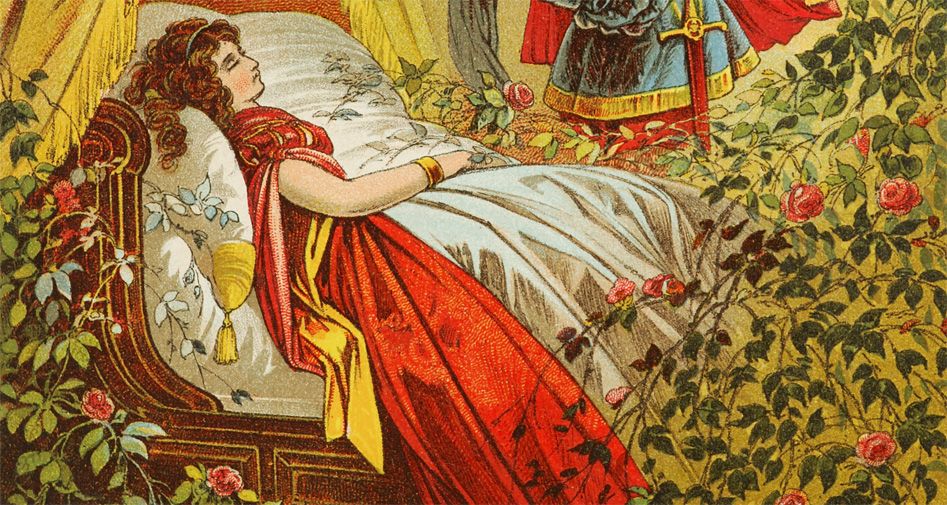
 Facebook
Facebook  Whatsapp
Whatsapp  Messenger
Messenger  Telegram
Telegram Reddit
Reddit












